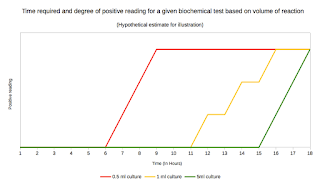Pore-fection aims perfection
Welcome back,
Photo 1: Search for Pore-fection; Article in Science (Link)
Science is a subject that you never get bored of. And "microbiology", definitely not. And that fuels to me to write. Few of a times, i have written pure microbiology and sometimes, i tried to address some common questions. Occasionally i have strayed away from the main topic, cause i considered that it was worth making a note of and hence an exception. Now, am in a similar situation. This is just fascinating and i have to write about it. Its a new leap in DNA sequencing technology.
We are in a age of scientific data explosion. From an era, where we didn't know what is the basic chemistry of life (Just half a century ago), we have leaped to a time where we can construct synthetic life (Oh, the credit goes to Craig venter's team. Read the story). And what made this possible is the ability to read the basic sentence coded in the genome of life (The DNA sequence). DNA Sequencing can be done by various techniques. Sanger’s method, Direct PCR Pyrosequencing, Maxam and Gilbert sequencing, automated fluorescent DNA sequencing etc are some methods that essentially works on similar principles. Please refer to my writing posted in notes section of my blog under “Techniques in Molecular Biology” in case you need background information.
But we are a crazy race. We are never satisfied. So we see disadvantages with these methods such as the machines are bulky and cost of sequencing is high, time consumption is more for whole genome and etc etc. And so the focus is now all on the next generation sequencing gadget with a method referred to as "Nanopore sequencing" or more commonly known as "Pore-fection". The article that caught my attention is shown here below.
Photo 1: Search for Pore-fection; Article in Science (Link)
The idea initially spoken out by David Deamer, teamed with Daniel Branton. Around the time, geneticist George Church independently developed the idea. Church pursued other sequencing projects, but Deamer kept working on the idea.
Photo 2: Sketch by David (Source), the original thoughts on Nanopore sequencing.
The idea behind this whole technology is just fascinatingly simple. The DNA is made to flow through a protein pore. This alters the ion flow through the channel. This ionic flow produced is different for each nucleotide. By measuring the signals of ionic flow this can tell you the base. Since this involves some pore forming protein, the bulk of machine is reduced at least theoretically. And since the whole thing is a single flow, this can be fast and efficient if fine tuned enough.
The first player to be studied as possible protein pore was α-hemolysin, which was studied by John Kasianowicz (he was investigating protein as potential biosensors for toxic heavy metals in solution) produced by S. aureus. In 1996 PNAS paper by Kasianowicz etal, they showed that electric field can drive single-stranded RNA and DNA molecules through a 2.6-nm diameter ion channel in a lipid bilayer membrane. (Click here for source). So the pore protein was ready. A second problem that needed to be solved was the speed of DNA/RNA moving through the pore. And it was moving fast, way too fast for them to get a well identifiable signal. In 2010, Akeson found the ϕ29 which can push long stretches of DNA, one base at a time, at a steady pace through α-hemolysin that allowed recording of signals. (Link).
Photo 3: Prof Mark Akeson
So, the problem solved? Ah not. They were not able to still get a clear distinct signal, they were not distinctive enough. So they had to search a better pore. The new pore MspA (Mycobacterium smegmatis porin A) was brought into lime limelight by Jens H. Gundlach. (Source). They were able to comment that "MspA had high signal-to-noise ratio and the single nucleotide sensitivity desired for nanopore sequencing devices." And finally with a new pore and a new polymerase, nanopore sequencing finally looks like a great possibility.
Fig 1: Schematic diagram of MspA (blue) set up in a lipid bilayer (grey). (Source)
Fig 2: DNA sequencing with nanopores (Gregory F Schneider & Cees Dekker; Source)
In a more recently published data in "Nature biotechnology", by M Akenson it was shown that Up to 500 molecules were processed at about 130 molecules per hour through one pore. (Click here for source). I would say thats an incredible improvement.
I would like to make a statement here. With more fine tuning, we will one day be able to sequence maybe an entire genome of human, design personalized treatment strategy (Area of pharmacogenomics) or take a sample in clinic put in some chip (just imagining), and say "well these are the organisms sitting in your wound" with a turn around time of less than a day. Not only will it be specific and cost effective, it will be mind blowing accurate. As Elizabeth Pennisi puts it in a podcast interview "Well, the first human genome took about three years to do. Now they can sequence a human genome in about a week. And with these new technologies – depending on how many sets of pores you use – they’re talking about doing it in an hour" and the device will be "little bit bigger than a thumb drive".
Pennisi E (2012). Genome sequencing. Search for pore-fection. Science (New York, N.Y.), 336 (6081), 534-7 PMID: 22556226
Further Reading:
Further Reading:
1. Gerald M Cherf etal. Automated forward and reverse ratcheting of DNA in a nanopore at 5-Å precision. Nature Biotechnology 30, 344–348 (2012). (Link)
2. Grégory F Schneider & Cees Dekker. DNA sequencing with nanopores. Nature Biotechnology 30, 326–328 (2012)











Comments
Post a Comment